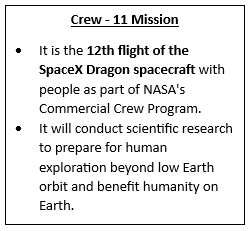Syllabus:
GS3: Awareness in the fields of IT, Space, Computers, robotics, nano-technology, bio-technology and issues relating to intellectual property rights.
Context:
Seeds of sea buckthorn and buckwheat grown in the cold desert of Ladakh are part of the experiments on board the International Space Station (ISS) flown by NASA’s Crew-11 mission.
More on the News

- The seeds are part of the “Emerging Space Nation’s Space for Agriculture & Agriculture for Space” payload that flew to the ISS along with NASA’s Crew-11, which lifted off from Florida and docked onto the orbital lab.
- Seeds procured from 11 nations across five continents are part of the study spearheaded by U.S.-based bioastronautics firm Jaguar Space, which plans to expose the seeds to microgravity conditions for a week.
- Seeds from the Maldives, Argentina, Brazil, Costa Rica, Guatemala, Armenia, Egypt, Pakistan and Nigeria are part of the experiment.
• The seeds will be brought back by Crew-10, which is expected to return to Earth later this month.
• The seeds grown in Ladakh were sourced by Bengaluru-based space start-up Protoplanet.
• Jaguar Space states that the World Seeds study explores how space conditions affect seeds before germination, focusing on gene activation and key metabolic processes.
• This experiment explores the potential of previously unexamined species to contribute to future space agriculture initiatives.
Sea Buckthorn
- Sea buckthorn (Hippophae rhamnoides) is a nutritious orange yellow berries grown in a hardy, thorny shrub native to the cold, arid regions of Europe and Asia, especially the Himalayan region, including Ladakh in India.
- It is known locally in Ladakh as Leh berry or Chharma.
Key Features:

- Bright orange berries rich in vitamins (especially C and E), antioxidants, omega fatty acids (3, 6, 7, and 9), and flavonoids.
- It thrives in poor, dry, high-altitude soils, which helps prevent soil erosion and fix nitrogen, making it ecologically valuable.
Uses:
- Medicinal: Supports skin health, immunity, and heart health.
- Nutritional: Used in making juice, jams, teas, oils.
- Environmental: Reforestation and land restoration in fragile ecosystems.
Buckwheat
- Buckwheat is a dicot herbaceous plant. It is commonly described as pseudo-cereal (consumed as cereal seed, does not grow as grass), a short-duration crop, a cash crop, and a hardy crop.
- It is a moisture-loving grain that is thought to be one of the most versatile crops for forage and food, and has several benefits for human health.
- It is grown for its grain-like seeds, and its name comes from the Anglo-Saxon words boc (beech) and whoet (wheat), as its seeds resemble beech nuts.
- In India, buckwheat is commonly known as Kuttu.
Key Features:
- It is a gluten-free alternative to wheat. It is grown in cold climates due to its short growing season.
- It is rich in fiber, protein, and essential minerals like magnesium, zinc, and iron.
- It contains antioxidants such as rutin, beneficial for heart health.
- It has a low glycaemic index, which is suitable for diabetics.
Uses:
- It is commonly used in porridge, pancakes, noodles, and flour-based foods.
- Buckwheat flour is a common ingredient in many fasting recipes in India.

